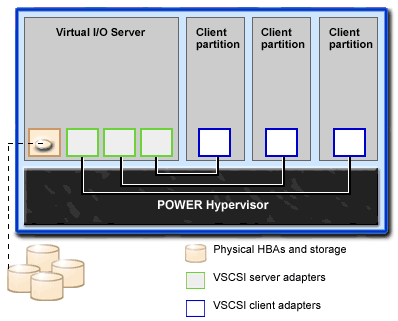Virtual SCSI
Using virtual Small Computer Serial Interface (SCSI), client logical partitions can share disk storage and tape or optical devices that are assigned to the Virtual I/O Server (VIOS) logical partition.
Disk, tape, Universal Serial Bus (USB) mass storage, or optical devices attached to physical adapters in the VIOS logical partition can be shared by one or more client logical partitions. The VIOS is a standard storage subsystem that provides standard logical unit numbers (LUNs) that are compliant with the SCSI. The VIOS can export a pool of heterogeneous physical storage as a homogeneous pool of block storage in the form of SCSI disks. The VIOS is a localized storage subsystem. Unlike typical storage subsystems that are physically located in the SAN, the SCSI devices exported by the VIOS are limited to the domain within the server. Therefore, although the SCSI LUNs are SCSI-compliant, they might not meet the needs of all applications, particularly those that exist in a distributed environment.
The following SCSI peripheral device types are supported:
- Disk backed by logical volume
- Disk backed by physical volume
- Disk backed by file
- Disk backed by a logical unit in shared storage pools
- Optical CD-ROM, DVD-RAM, and DVD-ROM
- Optical DVD-RAM backed by file
- Tape devices
- USB mass storage devices
Virtual SCSI is based on a client-server relationship. The VIOS owns the physical resources and the virtual SCSI server adapter, and acts as a server, or SCSI target device. The client logical partitions have a SCSI initiator referred to as the virtual SCSI client adapter, and access the virtual SCSI targets as standard SCSI LUNs. You can configure the virtual adapters and virtual disk resources by using the HMC or Integrated Virtualization Manager. The configuration and provisioning of virtual disk resources can be performed by using the HMC or the VIOS command line. Physical disks owned by the VIOS can be exported and assigned to a client logical partition as a whole, added to a shared storage pool, or can be partitioned into parts, such as logical volumes or files. The logical volumes and files can then be assigned to different logical partitions. Therefore, using virtual SCSI, you can share adapters and disk devices. Logical units in logical volumes and file-backed virtual devices prevent the client partition from participating in Live Partition Mobility. To make a physical volume, logical volume, or file available to a client logical partition requires that it must be assigned to a virtual SCSI server adapter on the VIOS. The client logical partition accesses its assigned disks through a virtual-SCSI client adapter. The virtual-SCSI client adapter recognizes standard SCSI devices and LUNs through this virtual adapter.
On the VIOS, for logical units in shared storage pools, you can thin-provision a client virtual-SCSI device for better storage space utilization. In a thin-provisioned device, the used storage space might be greater than the actual used storage space. If the blocks of storage space in a thin-provisioned device are unused, the device is not entirely backed by physical storage space. With thin-provisioning, the storage capacity of the storage pool can be exceeded. When the storage capacity is exceeded, a threshold exceeded alert is raised. To identify that a threshold alert has occurred, check the errors listed in the HMC serviceable events or the VIOS system error log by running the errlog command in the VIOS command line. To recover after the threshold has exceeded, you can add physical volumes to the storage pool. You can verify that the threshold is no longer exceeded in the HMC serviceable events or the VIOS system error log. For instructions on how to add physical volumes to the storage pool by using the VIOS command-line interface, see Adding physical volumes to the storage pool. For instructions on how to add physical volumes to the storage pool by using the VIOS configuration menu, see Adding physical volumes to the storage pool. You can also increase the storage capacity of the storage pool by deleting data.
On the VIOS, multiple applications running on the virtual client can manage reservations on virtual disks of the client by using the Persistent Reserves standard. These reservations persist across hard resets, logical unit resets, or initiator target nexus loss. Persistent reservations that are supported by logical devices from the VIOS shared storage pools support the required features for the SCSI-3 Persistent Reserves standard.
On the VIOS, you can thick-provision a virtual disk. In a thick-provisioned virtual disk, you can allocate or reserve storage space while initially provisioning the virtual disk. The allocated storage space for the thick-provisioned virtual disk is guaranteed. This operation ensures that there are no failures because of lack of storage space. By using thick-provisioning, virtual disks have faster initial access time because the storage is already allocated.
The following figure shows a standard virtual SCSI configuration.
